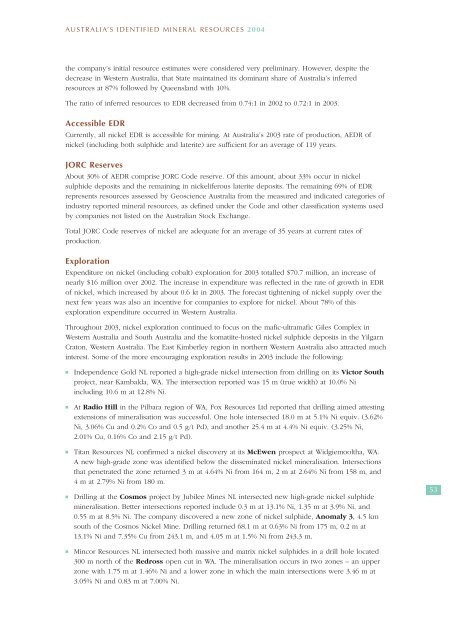australia's identified mineral resources 2004 - Geoscience Australia
australia's identified mineral resources 2004 - Geoscience Australia
australia's identified mineral resources 2004 - Geoscience Australia
You also want an ePaper? Increase the reach of your titles
YUMPU automatically turns print PDFs into web optimized ePapers that Google loves.
AUSTRALIA’S IDENTIFIED MINERAL RESOURCES <strong>2004</strong><br />
the company’s initial resource estimates were considered very preliminary. However, despite the<br />
decrease in Western <strong>Australia</strong>, that State maintained its dominant share of <strong>Australia</strong>’s inferred<br />
<strong>resources</strong> at 87% followed by Queensland with 10%.<br />
The ratio of inferred <strong>resources</strong> to EDR decreased from 0.74:1 in 2002 to 0.72:1 in 2003.<br />
Accessible EDR<br />
Currently, all nickel EDR is accessible for mining. At <strong>Australia</strong>’s 2003 rate of production, AEDR of<br />
nickel (including both sulphide and laterite) are sufficient for an average of 119 years.<br />
JORC Reserves<br />
About 30% of AEDR comprise JORC Code reserve. Of this amount, about 33% occur in nickel<br />
sulphide deposits and the remaining in nickeliferous laterite deposits. The remaining 69% of EDR<br />
represents <strong>resources</strong> assessed by <strong>Geoscience</strong> <strong>Australia</strong> from the measured and indicated categories of<br />
industry reported <strong>mineral</strong> <strong>resources</strong>, as defined under the Code and other classification systems used<br />
by companies not listed on the <strong>Australia</strong>n Stock Exchange.<br />
Total JORC Code reserves of nickel are adequate for an average of 35 years at current rates of<br />
production.<br />
Exploration<br />
Expenditure on nickel (including cobalt) exploration for 2003 totalled $70.7 million, an increase of<br />
nearly $16 million over 2002. The increase in expenditure was reflected in the rate of growth in EDR<br />
of nickel, which increased by about 0.6 kt in 2003. The forecast tightening of nickel supply over the<br />
next few years was also an incentive for companies to explore for nickel. About 78% of this<br />
exploration expenditure occurred in Western <strong>Australia</strong>.<br />
Throughout 2003, nickel exploration continued to focus on the mafic-ultramafic Giles Complex in<br />
Western <strong>Australia</strong> and South <strong>Australia</strong> and the komatiite-hosted nickel sulphide deposits in the Yilgarn<br />
Craton, Western <strong>Australia</strong>. The East Kimberley region in northern Western <strong>Australia</strong> also attracted much<br />
interest. Some of the more encouraging exploration results in 2003 include the following:<br />
■<br />
Independence Gold NL reported a high-grade nickel intersection from drilling on its Victor South<br />
project, near Kambalda, WA. The intersection reported was 15 m (true width) at 10.0% Ni<br />
including 10.6 m at 12.8% Ni.<br />
■<br />
At Radio Hill in the Pilbara region of WA, Fox Resources Ltd reported that drilling aimed attesting<br />
extensions of <strong>mineral</strong>isation was successful. One hole intersected 18.0 m at 5.1% Ni equiv. (3.62%<br />
Ni, 3.06% Cu and 0.2% Co and 0.5 g/t Pd), and another 25.4 m at 4.4% Ni equiv. (3.25% Ni,<br />
2.01% Cu, 0.16% Co and 2.15 g/t Pd).<br />
■<br />
■<br />
■<br />
Titan Resources NL confirmed a nickel discovery at its McEwen prospect at Widgiemooltha, WA.<br />
A new high-grade zone was <strong>identified</strong> below the disseminated nickel <strong>mineral</strong>isation. Intersections<br />
that penetrated the zone returned 3 m at 4.64% Ni from 164 m, 2 m at 2.64% Ni from 158 m, and<br />
4 m at 2.79% Ni from 180 m.<br />
Drilling at the Cosmos project by Jubilee Mines NL intersected new high-grade nickel sulphide<br />
<strong>mineral</strong>isation. Better intersections reported include 0.3 m at 13.1% Ni, 1.35 m at 3.9% Ni, and<br />
0.55 m at 8.5% Ni. The company discovered a new zone of nickel sulphide, Anomaly 3, 4.5 km<br />
south of the Cosmos Nickel Mine. Drilling returned 68.1 m at 0.63% Ni from 175 m, 0.2 m at<br />
13.1% Ni and 7.35% Cu from 243.1 m, and 4.05 m at 1.5% Ni from 243.3 m.<br />
Mincor Resources NL intersected both massive and matrix nickel sulphides in a drill hole located<br />
300 m north of the Redross open cut in WA. The <strong>mineral</strong>isation occurs in two zones – an upper<br />
zone with 1.75 m at 1.46% Ni and a lower zone in which the main intersections were 3.46 m at<br />
3.05% Ni and 0.83 m at 7.00% Ni.<br />
53

















